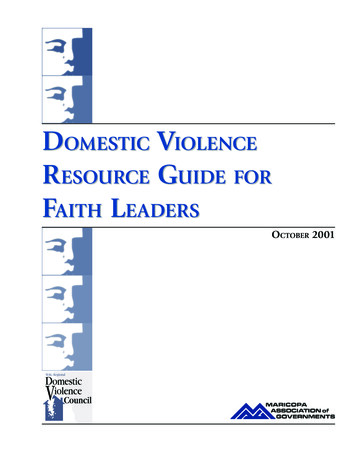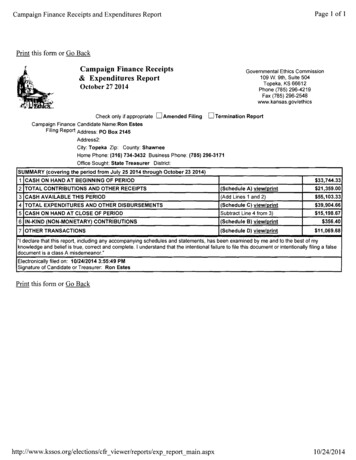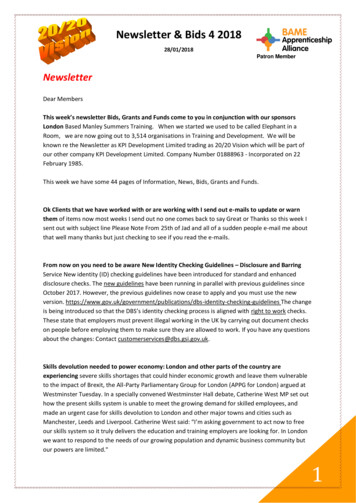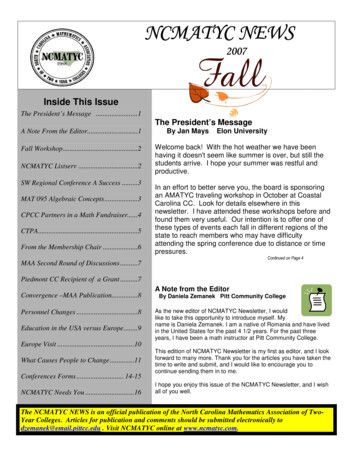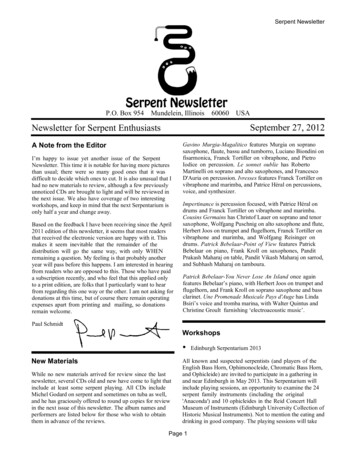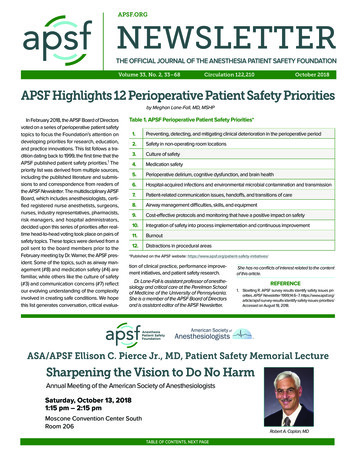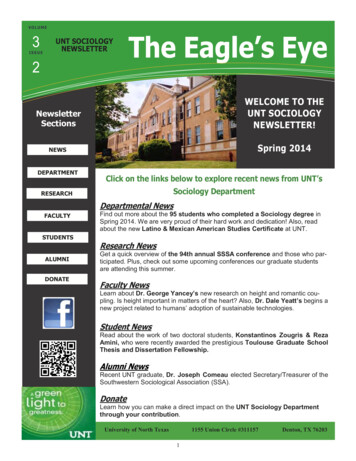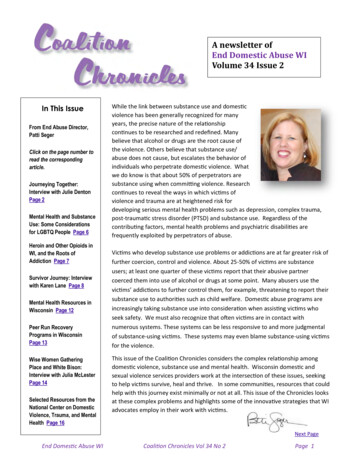
Transcription
A newsletter ofEnd Domestic Abuse WIVolume 34 Issue 2In This IssueFrom End Abuse Director,Patti SegerClick on the page number toread the correspondingarticle.Journeying Together:Interview with Julie DentonPage 2Mental Health and SubstanceUse: Some Considerationsfor LGBTQ People Page 6Heroin and Other Opioids inWI, and the Roots ofAddiction Page 7Survivor Journey: Interviewwith Karen Lane Page 8Mental Health Resources inWisconsin Page 12Peer Run RecoveryPrograms in WisconsinPage 13Wise Women GatheringPlace and White Bison:Interview with Julia McLesterPage 14Selected Resources from theNational Center on DomesticViolence, Trauma, and MentalHealth Page 16While the link between substance use and domesticviolence has been generally recognized for manyyears, the precise nature of the relationshipcontinues to be researched and redefined. Manybelieve that alcohol or drugs are the root cause ofthe violence. Others believe that substance use/abuse does not cause, but escalates the behavior ofindividuals who perpetrate domestic violence. Whatwe do know is that about 50% of perpetrators aresubstance using when committing violence. Researchcontinues to reveal the ways in which victims ofviolence and trauma are at heightened risk fordeveloping serious mental health problems such as depression, complex trauma,post-traumatic stress disorder (PTSD) and substance use. Regardless of thecontributing factors, mental health problems and psychiatric disabilities arefrequently exploited by perpetrators of abuse.Victims who develop substance use problems or addictions are at far greater risk offurther coercion, control and violence. About 25-50% of victims are substanceusers; at least one quarter of these victims report that their abusive partnercoerced them into use of alcohol or drugs at some point. Many abusers use thevictims’ addictions to further control them, for example, threatening to report theirsubstance use to authorities such as child welfare. Domestic abuse programs areincreasingly taking substance use into consideration when assisting victims whoseek safety. We must also recognize that often victims are in contact withnumerous systems. These systems can be less responsive to and more judgmentalof substance-using victims. These systems may even blame substance-using victimsfor the violence.This issue of the Coalition Chronicles considers the complex relationship amongdomestic violence, substance use and mental health. Wisconsin domestic andsexual violence services providers work at the intersection of these issues, seekingto help victims survive, heal and thrive. In some communities, resources that couldhelp with this journey exist minimally or not at all. This issue of the Chronicles looksat these complex problems and highlights some of the innovative strategies that WIadvocates employ in their work with victims.Next PageEnd Domestic Abuse WICoalition Chronicles Vol 34 No 2Page 1
Journeying TogetherInterview with Julie DentonWhat is the philosophy or mission of this program?The Journeying Together Program, like its sponsoring agency,Christine Ann Domestic Abuse Services, is committed to endingthe cycle of violence by providing safety, support and advocacyto abuse victims, particularly survivors of domestic violencewho are impacted by their own or another’s (usually theabuser) substance use, misuse or addiction.Who are your community partners?Our primary partner is Solutions Recovery Club (SRC), whichprovides a complementary support group called, “Sisters ofSerenity,” facilitated by a past Christine Ann resident with 10years of sobriety. She has recently completed training to be aPeer Support Specialist through NAMI. Any woman whoidentifies as “being affected by substance abuse” can attend.The women organize themselves to provide child care at theSRC building.Julie Denton has served at Christine AnnDomestic Abuse Services, Inc. for 21 years inthe capacity of Transitional Living Coordinator,Family Resource Advocate, Client ServicesManager, and recently, Shelter ServicesCoordinator. She has served since 2005 as aClient Representative on the Board ofDirectors for Legal Action. Since 2007, she hasbeen collaborating with the local recovery clubto offer support groups for survivors livingwith trauma, substance abuse and mentalhealth issues. Currently, she is serving as aTraining Leader and as an Outreach Advocateto underserved communities.Within the community, SRC serves as a central meeting place for all of the various 12-Step programs includingNarcotics Anonymous, Alcoholics Anonymous, Al-Anon, Gamblers Anonymous, Ala-teen and Adult Children ofAlcoholics. SRC provides an “organized system of support for the recovery population; one that compliments the 12Step programs outside of the primary and secondary treatment environment.” SRC also provides assistance in theprevention of relapse by creating a safe environment in which information, education and fellowship are readilyavailable. Additionally, the club provides a social meeting place with a number of different activities including a gameroom, coffee bar and more to help people in recovery meet other recovering people and to develop a “substancefree” social life.Other community partners to which Christine Ann staff may refer or that may refer potential Journeying Togetherparticipants are: Winnebago County Drug Court; Child Protective Services; County Clinical Services AODA Program andCrisis Intervention; Workforce Development Center TANF Employment Programs (W2 program in WI); Dept. ofVocational Rehabilitation; and STEP Industries (employer for people in substance abuse recovery).How long has it existed, and about how many people (survivors/consumers) have been part of it?Journeying Together includes three separate groups. We started the Stepping Stones group in 2007. Approximately425 women have attended the Stepping Stones group at least once. Step Sisters averages 4 to 8 women per group;Sisters of Serenity, which began in May, averages 8 to 15 women per group.How did you get started?In 2006, Christine Ann saw the need for a specialized program. Approximately one-third of the shelter residents in2006 reported having AODA issues. Christine Ann clients with substance abuse issues expressed a need for a programbecause they found that their abuser also attended the traditional 12-Step meetings, putting them at increased risk.Additionally, shelter staff identified a need for child care to enable clients to attend meetings and/or treatment. Theagency did not want to create a new treatment program but rather a program that introduced battered women to theconcept of recovery and to reinforce recovery principles. Although sobriety is a goal, the Harm Reduction Model wasmost compatible with domestic abuse advocacy.End Domestic Abuse WICoalition Chronicles Vol 34 No 2Page 2
After attending classes to earn a Substance Abuse Certificate at UW-Madison, I researched and presented threemodels for a support group to women interested in attending a program that addressed substance use. The womenchose a weekly group with a 12-Step structure, because it was the most familiar format to women in any recoveryprogram. They saw it as a “gateway” to the benefits and structure of a 12-Step program.Were there any bumps along the road and how did you get past them?A major barrier for the program was acceptance from the substance abuse community because it was new and nontraditional (i.e., it didn’t follow traditional 12-Steps), and it was not facilitated by an AODA counselor. Christine Annhad to educate treatment providers and reinforce that Journeying Together is not a treatment program, rather a“gateway” program for domestic abuse victims supporting recovery principles. A major change in AODA treatmenthas been the identification of trauma issues affecting women’suse of substances requiring “woman-specific, trauma-informed”Charlotte Kasl: 16 StepsAODA treatment services. We fit in well with that model.Sisters of Sobriety developed out of the most current barrier women did not want to be identified as attending “theaddiction group.” Both Step Sisters and Stepping Stones groupsare held at the shelter. Women would actively participate inthe beginning, but if they were struggling with cravings, theywould slowly (or quickly) quit attending. We decided to dividethe group. We would offer Step Sisters at the shelter forwomen to focus on empowerment. For Step Sisters, we chosethe “16 Steps of Discovery and Empowerment. Charlotte Kasl,the creator of the 16 Steps, allows groups to modify the originalsteps as long as she is cited in handouts. The group is open toany woman who would like to “affirm we have the power totake charge of our lives and stop being dependent on ournegative ways of coping, or other people, for our self-esteemand security.”We started Sisters of Serenity at Solutions Recovery Clubtargeting women who identify with having a substance abuseissue. Using “A Woman’s Way through the Twelve Steps,” weare able to address issues of abuse and trauma through themain topic of substance abuse. It serves as both an outreachgroup and as a safe, offsite group for women to attend.How is this program unique among other services, atyour agency or at other agencies in your community?Although the Journeying Together Program uses a formatsimilar to existing 12-step programs, it is professionallyfacilitated, based on trauma-informed principles and primarilyfocuses on sobriety and recovery as part of a domestic violencesafety plan.In the 16-step model, addiction is understoodas a complex web of social factors, physical,predisposition and personal history. A majortask of healing from addiction is to validate theunderlying, positive survival goals for safety,connection, pleasure, love and power. Itaddresses issues of cultural diversity andinternalized oppression: in this model, theconcept of “codependency” is understood as aform of internalized oppression in a culturalcontext as well as an individual problem. Whileit is crucial to acknowledge the power ofaddiction, this model helps people affirm thepower they do have to take charge of theirlives and overcome addiction. Developingone’s passion, finding purpose, bonding withothers and becoming involved in social changeare seen as antidotes to addiction. Thisapproach does not posture itself as the oneway or the right way, nor does it makeassumptions about the length of time it takesor the path that must be followed.Excerpted from the description of the 16 StepProgram at http://charlottekasl.com/16-stepprogram/Christine Ann’s Journeying Together Program is the only one ofits kind in Winnebago County, Wisconsin. It strives to meet the needs of battered women who are impacted by theirown or their partner’s substance use, misuse or addiction. Journeying Together’s overall goal is to help women attainsafety in their relationships, thinking, behavior and emotions. The program provides a safe place for victims to openlydiscuss their abuse issues among other women who struggle with the same issues.End Domestic Abuse WICoalition Chronicles Vol 34 No 2Page 3
The most innovative aspects of the program are: It makes safety a priority. Journeying Together uses the Harm Reduction Model making safety a priority, definingrecovery as supporting any positive change a participant makes toward addressing their substance abuse issuesas part of their domestic violence safety plan. Traditional 12-Step programs primarily focus on initiating andsubstance abuse recovery process and reinforce the skills needed to remaining abstinent rather than safetyplanning. The Journeying Together Foundation. All of the participants arevictims of domestic abuse. Some have coped with their abuse byusing substances. Some have coped with their abuse by going togreat lengths to “fix” themselves, their partners and theirrelationships. Some have done both. Journeying Together helpswomen to focus on their healing and that of their children byconcentrating on the “Steps Forward to Empowerment” (the 16Steps, the woman’s approach to the 12 Steps, and Stepping StonesGroup foundational 12 Steps to Living My Free Life). It addresses trauma and substance abuse. The Journeying TogetherProgram supports the victim and addresses trauma, substance abuse Support group participants take a shinystone to represent the beautiful shiningand domestic violence. Recovery from substance abuse/addictionand/or “codependency” is seen as part of an overall domesticsoul they were born with, which is stillviolence safety plan. Traditional 12-Step programs for substanceat their core no matter what hasabusers such as Al-Anon and Alcoholics Anonymous focus on helpinghappened in their lives.the substance abuser and family members deal with the effects ofsubstance abuse. They don’t address the effects of domestic abuse inthe family relationship. A popular model within the substance abuse treatment community is the “FamilyDisease” model. Codependency may be defined as “an emotional and behavioral condition that affects anindividual’s ability to have a healthy, mutually satisfying relationship.” Journeying Together views codependencywithin the context of a violent family relationship as a survival tactic. It offers a safe, confidential place to talk about abuse. Step Sisters and Stepping Stones participants considerChristine Ann to be a safe environment. Many of the incidents they discuss can be humiliating. They are able toshare their experiences and feelings with other women who understand their experiences and are committed tomaintaining confidentiality. The most well-known 12-Step programs (AA, Al-Anon, etc.) have a tradition ofanonymity, not confidentiality. Additionally, most 12-Step programs are mixed gender, which creates a safetyissue. Thinking they can trust group members because they are in recovery, domestic violence victims may sharevulnerabilities, making them a target for potential perpetrators who may be in the group. The women whoattend Sisters of Serenity may never walk through the doors of the Christine Ann Center. We provide an advocateto talk with the women in a space that is comfortable to them. An outside client intake is completed if theywould like to access Christine Ann’s services. It offers childcare. Step Sisters and Stepping Stones offer childcare to participants, without which some of thewomen would not be able to attend. In fact, no other 12-Step program in the agency’s service area provideschildcare. Because the Sisters of Serenity is off-site, Christine Ann is unable to provide childcare. The mothers inthe group have taken it upon themselves to watch each other’s children at the SRC and sign up weekly for theresponsibility.What is one success that stands out to you?Katrina, a survivor of domestic abuse and previous shelter resident, had been clean and sober for 3 months when shebegan participating in Stepping Stones. From age 11, she had not been sober for more than 6 months. Katrina andher husband had both abused substances throughout their relationship, which began when she was 14 years old.She had returned to her husband of 26 years because he said he would work on the relationship and would quit usingEnd Domestic Abuse WICoalition Chronicles Vol 34 No 2Page 4
drugs. After he beat her, she came back to Christine Ann.While in shelter, Katrina found emotional support in SteppingStones, where she learned that her husband used hersubstance use as a tactic to control and shame her. Shelearned how she used substances to numb her feelings, how itleft her vulnerable to her husband’s emotional abuse andphysical violence, and about trauma and boundary-setting.Katrina began to view her sobriety maintenance as a key partof her safety plan. Staff introduced her to the SolutionsRecovery Club where she attended Narcotics Anonymous.She became an active volunteer in order to support hersobriety. Katrina learned to view herself as a woman whodeserved respect.After several months of emotional support, learning how toproblem-solve and how to trust herself and her skills, Katrinamoved into Christine Ann’s Transitional Living Program. Staffassisted her with obtaining insurance. As a result, she wasable to work with a trauma therapist to assist her in healingfrom PTSD and medication for treatment of bipolar disorder.Since then, she has developed sober, supportive friendshipsthrough the recovery community, reunited with her estrangedadult children, and obtained a divorce. She currentlycelebrates 5 years of sobriety and provides peer support in asober living home.RECOMMENDED BOOKS &WORKBOOKS A Woman’s Way Through the Twelve Steps,Stephanie CovingtonA Woman’s Way Through the Twelve StepsWorkbook, Stephanie CovingtonMany Roads, One Journey: Moving Beyond the 12Steps, Charlotte Davis KaslWomen, Sex, and Addiction: A Search for Love andPower, Charlotte Davis KaslYes You Can!: Healing from Trauma and Addictionwith Love, Strength, and Power Based on the 16Steps, Charlotte Davis KaslDAILY MEDITATION BOOKS The Language of Letting Go: Daily Meditations onCodependency, Melody Beattie A Woman’s Spirit, Karen Casey Each Day a New Beginning: Daily Meditations forWomen, Karen Casey Time to Break Free, Meditations for the First 100Days after Leaving an Abusive Relationship,Judith SmithWhere do you find inspiration? Katrina.What advice would you give to someone who wantedto start a similar program or collaboration in theircommunity? Stephanie Covington, PhD LCSWhttp://www.stephaniecovington.com/Stephanie Covington focuses on genderresponsive and trauma-informed services. She iswell-known for her work with women inrecovery, and developed curricula that can beadapted for support groups.Talk to clients who have “clean time” and might be willingto attend group regularly.Begin with a “codependency group” – it will includewomen whose relationships are affected by substance use(their partner’s or their own). As the group develops, aSisters of Serenity type group will grow out of it.If you have a local recovery club (Alano, etc.), try to build a Visit the Wisconsin Association of 12 Step Clubsrelationship with them. Some may have a very strict ideato find the nearest club on their interactive map.of the groups they will allow in their building (only AA orClick on a location for address and contact info.NA). At the very least, they will see your agency as an ally.Get involved with any local efforts to address opiate addiction in your community. They are very open toanything that will support recovery. (See page 7 for information about heroin use and opiate addiction treatmentin Wisconsin.)If possible, take some classes in AODA counseling. I attended UW Madison’s Continuing Education program andreceived a “Certificate of Competence” which helped me feel more knowledgeable and gave me some credibilityin the AODA treatment community.Stress that you are supporting recovery, not providing treatment. We don’t want to be perceived as “AODAcounselors” in the community or by our clients. We support recovery as a part of a domestic violence safety plan.Back to Table of ContentsEnd Domestic Abuse WICoalition Chronicles Vol 34 No 2Page 5
Let’s Talk About It:A TransgenderSurvivor’s Guide toAccessing TherapyLGBTQ Persons and Mental HealthLGBTQ people have experienced de-humanizing aggression associated withour mental health. For decades we have been diagnosed, medicated, andtreated on the misconception that our sexual and gender identities andexpressions were mental illnesses.Thus stigmatized, it is often challenging to address the concerns we face on aregular basis. In short, we become too familiar with the question, “Am Icrazy?” And sometimes, this feeling is reinforced by our sense that bystandersare watching our mistreatment with little or no interest in addressing it. Wethen walk around questioning whether anyone else notices.It is little wonder then that the data about LGBT mental health are appalling.LGBT youth and adults are significantly more likely to feel depressed, to feelanxious and to think about suicide than our heterosexual peers. For teensespecially, these issues are highly associated with school and communitybullying. However, bullying is but one obvious example of the stressors thatcontribute to these differences from our heterosexual peers.LGBTQ Persons and Substance UseFor some LGBT people, addressing their use of substances is challenged by alimited number of culturally competent AODA providers and by a lack ofinsurance coverage for such services. For others, substance use is viewed as arite of passage, a factor associated with community membership or a methodof coping with the stressors associated with homophobia. It seems thatconfronting their substance use and abuse feels like a personal attack forsome LGBT people.In the US, bars and clubs have played a vital part in the development of LGBTcommunities. Even today, especially in smaller and less developedcommunities, the importance of bars to the LGBT community cannot beoverstated. This greatly complicates the mechanisms to address substanceuse.Thinking Under the InfluenceThinking Under the Influence is an alcohol-reduction program that gives LGBTpeople knowledge and skills to reduce the risks associated with using alcohol.The program also teaches young people about how the entire LGBTcommunity is affected by alcohol.Learn more about Thinking Under the Influence.The above information is excerpted from the Diverse & Resilient website.Accessed September 1, 2015.End Domestic Abuse WICoalition Chronicles Vol 34 No 2Let’s Talk AboutIt! While manytransgender people seeindividual therapists,choosing and workingwith a therapist can bemore complex for thehalf of transgenderpeople who are alsosexual assault survivors.This 107-page guideaddresses many of thespecific questions transsurvivors ask: how todecide if therapy is rightfor you; if it is, how tochoose the best type oftherapy for you; andhow to find referralsand choose atherapist. The guidealso discusses transspecific survivor issuessuch as dealing withStandards of Careissues; addressingshame and body image/dysphoria issues; andnavigating sexsegregated services.This guide waspublished by Forge inMay, 2015.Learn more ordownload this resourcefrom Forge.Back to Table of ContentsPage 6
Heroin and Other Opioid Addiction News and Resources in WisconsinThe Wisconsin Department of Health Services lists local substance abuse services and certified opioid addictiontreatment providers with contact information. Certified providers are located in: Appleton, Beloit, Eau Claire, Fonddu Lac, Green Bay, La Crosse, Madison, Milwaukee, Onalaska, Racine, Sheboygan, Waukesha, Wausau and WestMilwaukee.In 2015, the Department of Health Services awarded grants to three HOPE (Heroin, Opiate Prevention andEducation) Programs to serve rural, underserved areas of Wisconsin. When fully operational they will provideservices including detox, counseling, abstinence-based treatment, medication-assisted treatment and residentialtreatment. The grantees are: HSHS St. Joseph's Hospital of Chippewa Falls through Libertas of Marinette in collaboration with PreveaHealth (serving Florence, Marinette, and Menominee counties) Family Health Center of Marshfield/North Central Region Opioid Consortium (serving Forest, Iron, Oneida,Price and Vilas counties) Northlakes Community Clinic of Ashland (serving Ashland, Bayfield, Burnett, Douglas, Sawyer and Washburncounties)For background information, view Wisconsin’s Heroin Epidemic: Strategies and Solutions. Analysis andRecommendations for Reducing Heroin Abuse in Wisconsin, published in July 2014 by the Wisconsin State Council onAlcohol and Other Drug Abuse Prevention Committee Heroin Ad-hoc Committee.The Roots of AddictionThis 3-minute video of Dr. Gabor Maté was published by KidCareCanada on June 1, 2013.Over many years Dr. Gabor Maté has worked as a family physician, explored ADHD and treated people sufferingfrom addictions. In this video, he briefly discusses addiction as an escape from psychic pain that is rooted inchildhood experiences. He notes that, although addiction is often multigenerational and runs in families, it hasnothing to do with genetics but is caused by emotional patterns and behaviors that give rise to the same pain andthe same desire to escape from it.View the video.In the Realm of Hungry Ghosts: CloseEncounters With Addiction (2008)Dr. Gabor Maté argues that there is only one addictionprocess, whether manifested as a socially unacceptablelethal substance dependency or the socially acceptableor even admired behaviors of the workaholic. In thisbook, the author shares his experiences as a medicaldoctor in Vancouver’s drug ghetto and draws fromextensive interviews with his patients. He presentsinformation, reflections and insights distilled from manyother sources, including his own addictive patterns. Thebook also provides a synthesis of research literature onaddiction and the development of the human brain andpersonality.Read the full introduction.End Domestic Abuse WIImage taken on September 1, 2015 ngry-ghosts/Coalition Chronicles Vol 34 No 2Back to Table of ContentsPage 7
Survivor Journey: Interview with Karen LaneWhen you think about your process of healing, what stands outfor you?When I think of my healing process, what stands out for me was the pressure Ifelt to heal. It seems everyone wanted me to hurry up and heal. I haveexperienced childhood sexual abuse, witnessed the domestic violence upon myfamily members, experienced domestic violence as a young adult andexperienced sexual assault from a healthcare provider as an older adult. That isa lot to process and from which to heal.We live in a fast-paced culture that is used to immediate gratification. Healinghappens at its own pace. Most important, healing happens when one feels safeto heal. Having a mental health issue and having a substance use issue werefactors that also played a role in the healing process. Listening to my body andmy felt sense of self as to when and where healing would be possible was a keyfactor in healing. The pressure placed on us–by well-meaning and importantpeople in our lives–to “just get over it” can be very strong. Learning to say “no”when I didn’t have the energy to meet other people’s needs in my life was veryhelpful for defining what safety was for me and for creating boundaries thatwould keep me safe. Healing at my pace and on my terms created the veryboundaries I needed to keep safe. I am still learning this, and I am still healing.Karen M. Lane lives in RiceLake, Wisconsin. She bringsover 20 years of experienceworking with persons withlived experience of mentalillness in a variety ofcapacities. Karen is a survivorand has lived experience withmental illness. She currentlyis employed with DisabilityRights Wisconsin as anAdvocacy Specialist and hasbeen working with DisabilityRights Wisconsin for 11years. For 13 years she hasbeen part of Disability RightsWisconsin’s Violence AgainstWomen with DisabilitiesAccessibility Project.Compliance to what others thought would be good for me to heal, such asmaking me go to treatment, did not create safety or healing for me. It onlyfurthered my sense of helplessness created by the abuser and was just anotherarea of my life I would have to hand over to another person whom I was notsure I could trust. What did help me was working with a treatment providerwho fostered my desire for independence by working on the issues I felt I needed to address. This fostered in me asense of confidence that I could indeed take care of myself in safe and healthy ways.Lastly, I surrounded myself with people who allowed me to be me in the process of healing. Having people in mylife who did not focus on the illness was important for my recovery. They allowed me to make mistakes and tolearn from them. They allowed me to have dignity in my struggle to recover and to discover what I needed to dofor myself. They supported and respected my decisions even if they did not agree with them. They understoodthat healing is a journey with no specific end point: while the pain of suffering diminishes over time, the woundmay always be there to some extent, and learning that we never go back to where we were before healingfacilitates more healing. Ultimately, they did not blame me for having vulnerabilities.What would you want to tell another person going through a similar experience?I would say take things slowly. The abuse more than likely just didn’t happen overnight and neither will recovery. Ispent time “remembering.” That is, I spent time remembering who I was before the abuse took place,remembering my goals, dreams, and aspirations. There were a lot of people who thought I needed formal mentalhealth services in order to recover. While I did seek those services, where I found most of the “stuff” of healingwas from peers who had been through what I had experienced. I found mental health consumer, peer-operatedservices such as recovery centers to be very supportive of my journey. I found others who had experiences such asmine, and they shared their journeys. It was this reciprocal engagement that bore witness to each of our journeysEnd Domestic Abuse WICoalition Chronicles Vol 34 No 2Page 8
that often helped me move forward toward the life I was seeking. I would also say that it is easy to blame one’s selfwhen one is living with a mental illness and/or substance use disorder. It is also easy for the abuser to use this againstthe survivor, and for well-intentioned people to excuse the behavior of the perpetrator by seeing the illness/use ofthe survivor rather than seeing the person. For the survivor, this becomes: it must have been something I did or if Ijust wasn’t so crazy, maybe s/he would not have done this to me.What is often not recognized is how the disability is used against thesurvivor. Often there was not money for the medication I neededbecaus
Journeying Together includes three separate groups. We started the Stepping Stones group in 2007. Approximately 425 women have attended the Stepping Stones group at least once. Step Sisters averages 4 to 8 women per group; Sisters of Serenity, which began in May, averages 8 to 15 women per group.


